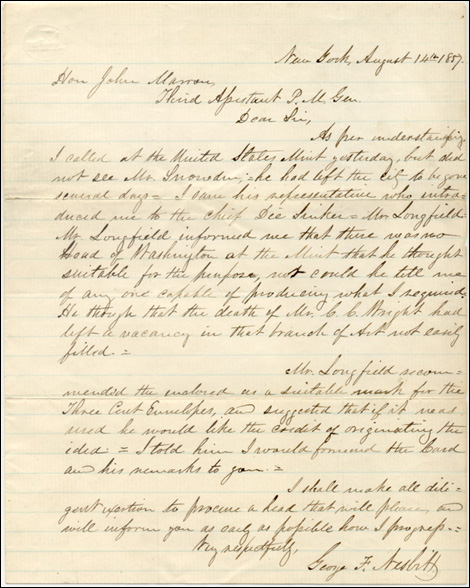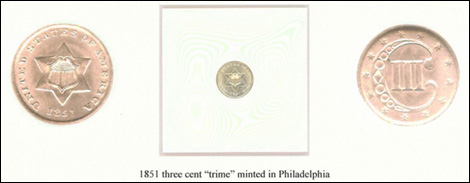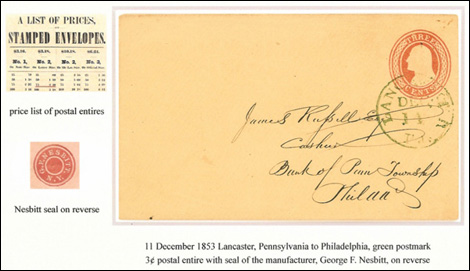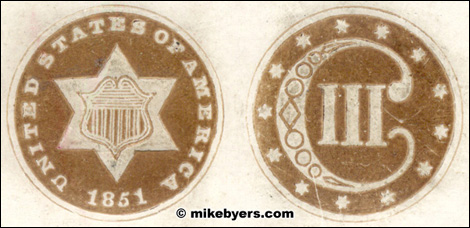 This is a spectacular 1851 3¢ Obverse and Reverse Die Trial struck on cardboard. This glaze-surfaced card is .35mm thick and measures 85mm wide by 50mm tall. It is clearly embossed with lettering and design elements raised. After the dies struck the cardboard, a bronze-gold ink was applied to show the high relief.
This is a spectacular 1851 3¢ Obverse and Reverse Die Trial struck on cardboard. This glaze-surfaced card is .35mm thick and measures 85mm wide by 50mm tall. It is clearly embossed with lettering and design elements raised. After the dies struck the cardboard, a bronze-gold ink was applied to show the high relief.
 This die trial is featured in the Judd 9th Edition of United States Pattern Coins on page 296 as the Plate Coin JA1851-1. There are two known examples, one in the Library Company of Philadelphia collection that includes a March 24, 1851 letter from James Longacre to the Secretary of the Treasury stating that "It is the first impression I have taken from the dies I have been preparing for the three cent piece ordered by congress."
This die trial is featured in the Judd 9th Edition of United States Pattern Coins on page 296 as the Plate Coin JA1851-1. There are two known examples, one in the Library Company of Philadelphia collection that includes a March 24, 1851 letter from James Longacre to the Secretary of the Treasury stating that "It is the first impression I have taken from the dies I have been preparing for the three cent piece ordered by congress."
 This example includes an August 17, 1857 letter from George F. Nesbitt, who was contracted to supply imprinted postal stationery to the Post Office Department from 1853 until 1870. He was searching for a die that could be used to emboss postal stationery. Longacre, who designed the three cent piece, supplied him with this 3¢ Obverse & Reverse Die Trial that had been produced in 1851. Nesbitt's letter to Third Assistant Postmaster General:
This example includes an August 17, 1857 letter from George F. Nesbitt, who was contracted to supply imprinted postal stationery to the Post Office Department from 1853 until 1870. He was searching for a die that could be used to emboss postal stationery. Longacre, who designed the three cent piece, supplied him with this 3¢ Obverse & Reverse Die Trial that had been produced in 1851. Nesbitt's letter to Third Assistant Postmaster General:

Here is the content of the letter:
"I called at the United States Mint yesterday, but did not see Mr. Snowden. I saw his representative who introduced me to the chief Die Sinker = Mr. Longfield (error for James Barton Longacre). Mr. Longfield informed me that there was no Head of Washington at the Mint that he thought suitable for the purpose, nor could he tell me of any one capable of producing what I required. He thought that the death of Mr. C.C. Wright had left a vacancy in that branch of art not easily filled.
Mr. Longfield recommended the enclosed as a suitable mark for the three cent envelopes, and suggested that if was used he would like the credit of originating the idea. I told him I would forward the card and his remarks to you.
I shall make all diligent exertion to procure a head that will please and will inform you as early as possible how I progress." |

The March 3, 1851 Act of Congress reduced the postal rate for a single letter sent up to 3,000 miles to three cents. The 3¢ stamp was issued on July 1, 1851 for prepayment of this postal rate.


This same act of March 3, 1851 also authorized the first issuance of a three cent coin. This is the first instance of a coin being issued directly to aid in the payment of a postal rate in the United States.

The three cent envelopes issued in 1853 were the first postal stationery of the United States.


These were manufactured by George Nesbitt & co. and he placed his embossed seal on the reverse until ordered to discontinue the practice on July 7, 1853. These were intended to be purchased in bulk by business users at a slight advance over the imprint stamp value. A quantity of 75 of these would have cost the purchaser $2.39.

Very few patterns and die trials illustrated in the Judd book include pedigree dating back to when they were originally struck.


